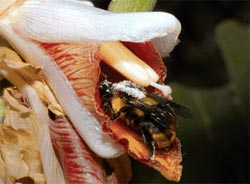
With 230 species throughout tropical and subtropical Asia,
Alpinia is the largest, most widespread and most taxonomically complex genus in the ginger family (Zingiberaceae). Species of
Alpinia often predominate in the understory of forests, while others are important ornamentals and medicinals. By using DNA sequence-based methods, Prof. Li Qingjun from the CAS Xishuangbanna Tropical Botanical Garden and his collaborators from the U.S. National Museum of Natural History and U.K Royal Botanic Garden have set up the monophyly of the genus. Their work is highlighted on the cover of the first issue of
American Journal of Botany in 2005.
The botanists sequenced 72 species of
Alpinia, 27 non-Alpinia species in the subfamily Alpinioideae, eight species in the subfamily Zingiberoideae, one species in the subfamily Tamijioideae, and three species in the outgroup genus
Siphonochilus (Siphonochiloideae) for the plastid
matK region and the nuclear internal transcribed spacer (ITS) loci. Parsimony analyses of both individual and combined data sets identified six polyphyletic clades containing species of
Alpinia distributed across the tribe Alpinieae. These results were supported by a Bayesian analysis of the combined data set. The researchers reveal that, with a few exceptions in specific cases, these monophyletic groupings of species do not correspond with the previous classification of the genus. Furthermore, they built on previous molecular analyses of the Alpinioideae and made proposals on the steps to recognize new generic boundaries in the Alpinieae.





